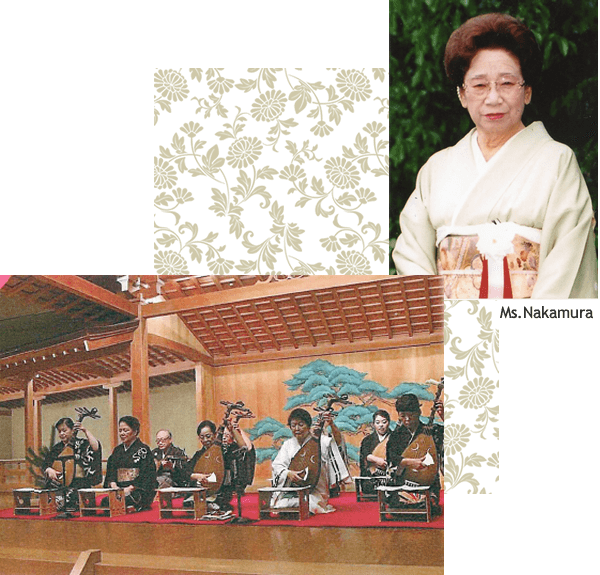Cool Japan, Hot Fukuoka!
Hinamatsuri
Families with young girls display decorated "hina ningyou" or hina dolls on a 5-tier base which is often covered with red curpet. Some dolls are dressed in traditional clothing. The snacks also follow a set of customs. Rice crakers and diamond shaped mochi cakes of sticky beaten rice are set out with sushi and white sake.
In some parts of Japan, people celebrate Hina Matsuri by making paper dolls and placing them in the river. This practice is called "Nagashi Bina" and was originally done to keep evil spirit away.
Traditionally, dolls are passed from mother to daughter and taken with them when they get married, this custom is still observed.
Order
The Emperor, The Empress,
Three Court Ladies
Five musicians, (from right) Singer, Flutist, Small hand drummer, Large hand drummer, Drummer
In Fukuoka Prefecture you can see Hinakazari in March. Hina dolls and Ornaments (Sagemon)in Yanagawa city and Iizuka City are very well-known.
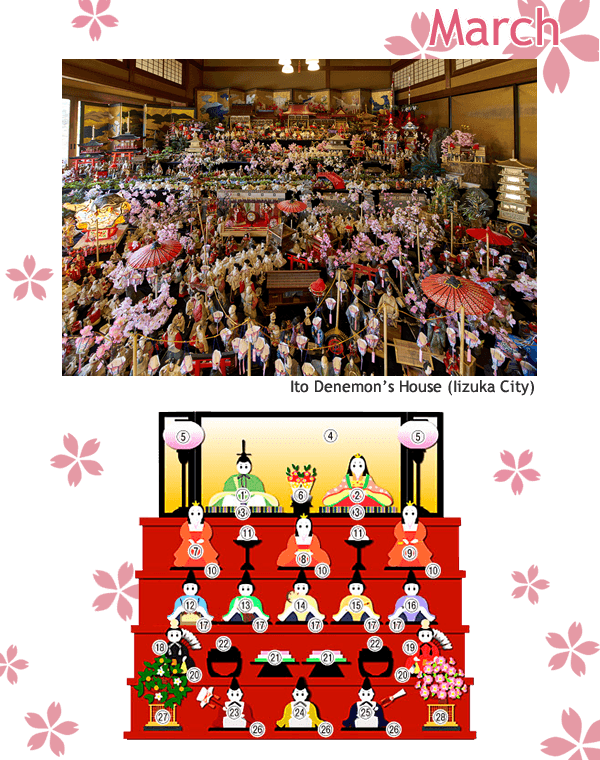
Dontaku
Dontaku is a big festival in Fukuoka City held on May 3rd and 4th that draws more than 1,000,000 people to the City.
It began under a different way in November 1595, as a way for the citizens of Hakata to honor their Lord Hideaki Kohayagawa living in Najima Castle. Lord Kohayagawa is known for his betrayal of Mitsunari Ishida. It was held on New year's until 1949, when the date was changed to what it is now to fall in line with the national holiday, Constitution Day.
Dontaku comes from the Dutch word "Zontag", meaning "Sunday" .
During the two days of festival, many groups called "Matubayasitai" perform dances and songs from around the world on stages or in the parade that goes from Kushida Shrine to Fukuoka City Hall.
One item seen during Dontaku is the "Shamoji", a scoop used to serve rice.
They are used in the festival for dances or to cheer others.
You also can see 3buses decorated with flowers and lights are driven around Fukuoka City.
Some believe Dontaku to be jinxed as it typically rains during the festival. But please come to Fukuoka City on 3rd and 4th in May to see Dontaku. You will really enjoy it.
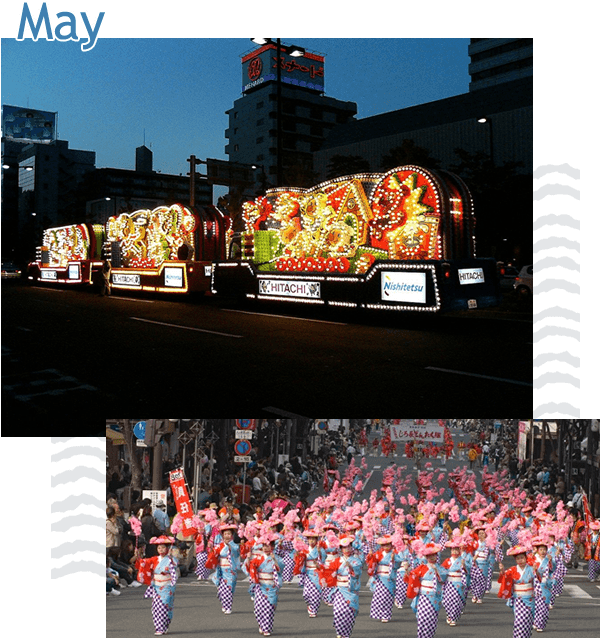
Gion Yamagasa
Yamagasa was started in the kamakura Period in 1241 by the lead Priest of Shouten Temple. AT the time, a plague was spreading throughout Hakata and it was believed that a new ritual would help. He was carried on a wooden float through the city, splashing water and praying to cleanse the people. These practices are very similar to what we see today.
Yamagasa is held from the 1st to the 15th of July. During this time, many decorated floats known as "Kazariyama" are displayed throughout Fukuoka and Hakata area.
They make for good photos and more are made each year. One is displayed year round at Kushida Shrine.
The ritual climaxes on the 15th when smaller floats (Kakiyama) are run through the streets as fast as the participants can carry them and splash water in a time trial along a 5 km course.
The only prize for the fastest time is pride typically, only men carry the floats, shouting "O-shoi" as they run.
The floats leave the starting line 5 minutes apart, making for an exciting time.
In 2016, Yamagasa was registered on the UNESCO Intangible Heritage list with another four floats in Kyushu.
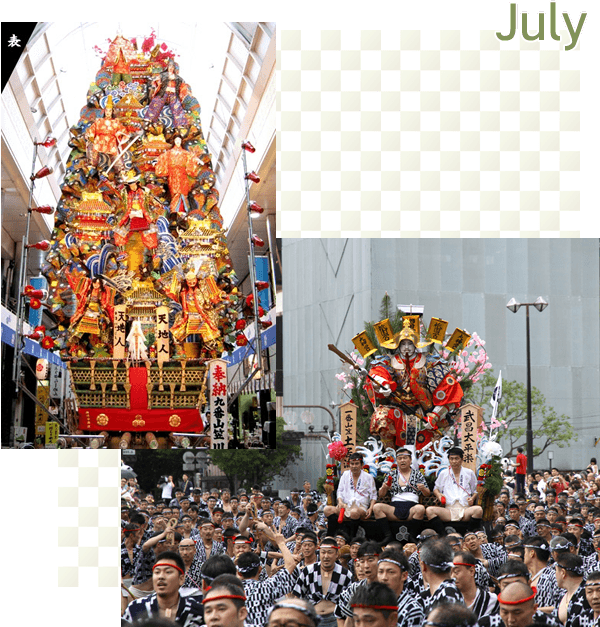
Ginkenshibudou
Ginkenshibu is a traditional Japanese art form that typically follows one of three styles, Ginei, Kenbu and Shibu.
Ginei involves only singing Chinese or Japanese Poems.
Kenbu is similar to Giei, but there is an additional performer dancing with a sword.
The final form, Shibu , a dancer performs with a fan while Chinese or Japanese Poems are sung.
Ginkenshibu is very popular in Japan. The Fukuoka Ginkenshibu association (Ginkenshibudo) has over 2,500 members.
During the Nara, Heian period, Poems were often written in Chinese and sung by nobles.
Later, this art form was also commonly performed by soldiers and priests.
By the end of the Edo period it was entertainment for the population as a whole, as it embodied the spirit of Bushido, good manners and dignity.
You can see Ginkenshibu movements on You Tube of Fukuoka Prefecture Arts and Culture Federation
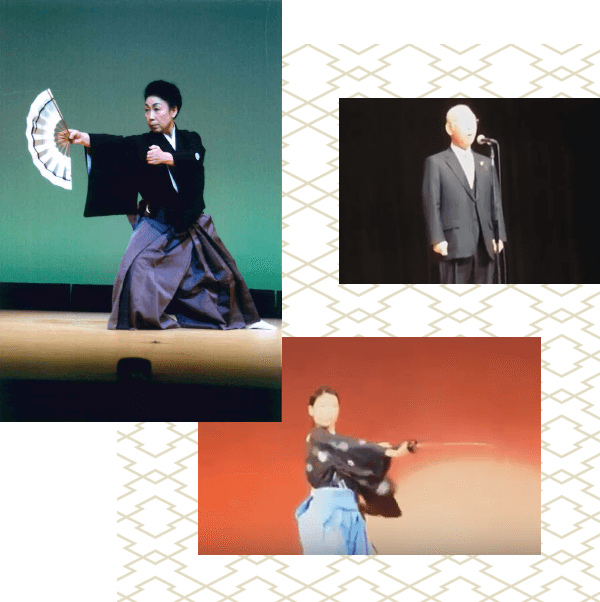
Kabuki
Kabuki originated in the early Edo period in Kyoto. A woman named Okuni of Izumo first performed it as an original dance. This custom was maintained and became modern Kabuki. Kabuki dance was later performed by only men.
Kabuki performs on a wooden revolving stage. During the performance actors often make poses when emotion peak. We call this art of posing "Mie" and some Actors are quite famous and popular for it.
An actor in a male role covers his face in white make up with red lines. This style is called "Kumadori". For those in female roles, they still use the white make up, but they do not use the red lines, they only use red on their lips. The female roles are played by men called "Oyama".
Some Actors are quite well known and respected for their female roles.
The stories used for Kabuki are often traditionally set in the Edo Period and have been performed for hundreds of years.
Recently a new form of Kabuki, called Super Kabuki has become popular. They use new stories from modern Japanese popular culture.
The most recent is based on "One Piece" a popular Japanese comic.
In Fukuoka you can see Kabuki at Hakataza(博多座)in February, June and November.
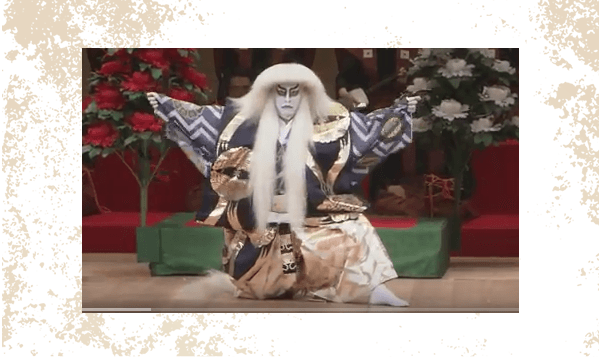
Hakataza (博多座)
Shimokawabatamachi Hakata ku Fukuoka City JAPAN
〒 812-8615
TEL:(092)263-5858 FAX: (092)263-3630
Kagura
Kagura is a Shintou dance traditionally performed to appease the Kami (Gods) to aid people in their endeavors.
It was considered a necessity for farmers who relied on the Kagura for good harvests, good weather (especially) and good health.
The ceremony was held at shrines and originally organized by the Government. Later on, locals took change of the event. A typical Kagura Performance involves a dance wearing a frightful mask, representing a god. The dances have a story but they are considered to be very difficult so, few can carry out this Shinto ritual.
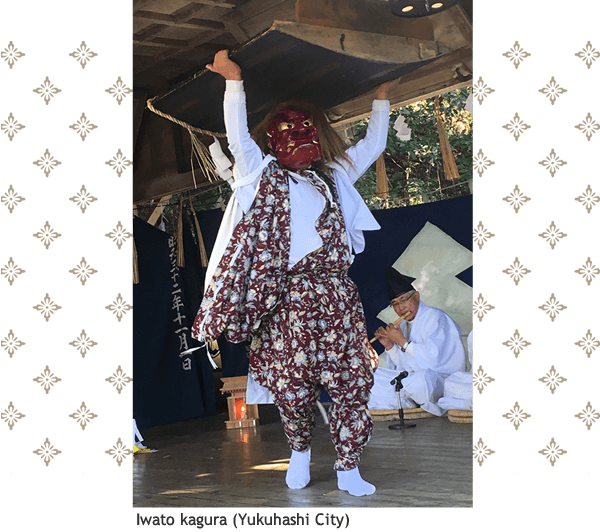
Nou・Kyougen
Nou and Kyougen originated in the art of music, dance and mimic play called dengaku and sarugaku in the Muromachi era. They are completed by Kanami and Zeami(father and son).
Nou and Kyougen are a traditional Japanese performance art that predates Kabuki. Nou tends to be serious art is done in classical Japanese. There are 260 musical scores used in traditional Nou plays. The "hayasi" (one or more instruments) ensemble play an assortment of drums and flutes. "Utai" or the vocal portion, is sung in a chanting style.
The Actors wear ornate to be treasures and passed down from generation to generation.
In Fukuoka Nou is performed at the Noubutai theater located in Ohori Park. The stage is made up of a 6m square called a Hon butai and a walkway is known as the Hashikagari. Noubutai is made by Honbutai(about 6m square)and "Hasikagari"(it looks like corridor).
A Nou performance is often a collection of smaller plays. A standard performance often takes about 1 hour and consists of 2 nou stories with as shorter, comedic play named Kyougen in between.
In Fukuoka you can see Nou and Kyougen at the Ohori Kouen Nougakudou.
(Nou theatre)
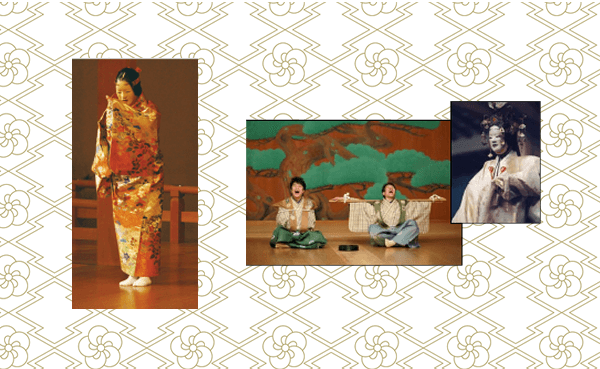
Ohori Park Nougakudou(大濠公園能楽堂)
1-5 Ohorikouen Chuou Ku Fukuoka City Japan
〒 810-0051
TEL 092-715-2155 FAX 092-715-2244
Tea Ceremony
"Sado" is the way to make and serve traditional Japanese tea.
It is sometimes called "Chanoyu". The tools are beautiful artistic things.
The beauty and cultural is not only in the tea, but also in the implements used to make tea.
Tea ceremony came from China during Tou period (618~907). Sen No Rikyu is the most famous master in Japan spread tea art Japan.
Tea ceremony has a spiritual correction with Buddhism (Zensyu).
We call it "Wabi, Sabi" mean to be discreet in word and deed.
We must concentrate to make green tea, and be calm ourselves.
The manner
While it may seem easy, many spend years learning ""The way of tea."
First pour hot water over tea in the bowl stirring with a bamboo whisk, until bubbles begin to form.
Next, take the tea bowl in two quarter turns, as drinking from the front is taboo.
Finally, after drinking the tea, wipe the edge of the tea bowl from where you drink with your finger and clean your finger using Kaisi, a paper traditionally used in the ceremony.
The tea ceremony and even the room are all cultural treasure of Japan.
Tea ceremony not only calms your spirit,but bridges gaps between cultures and people.
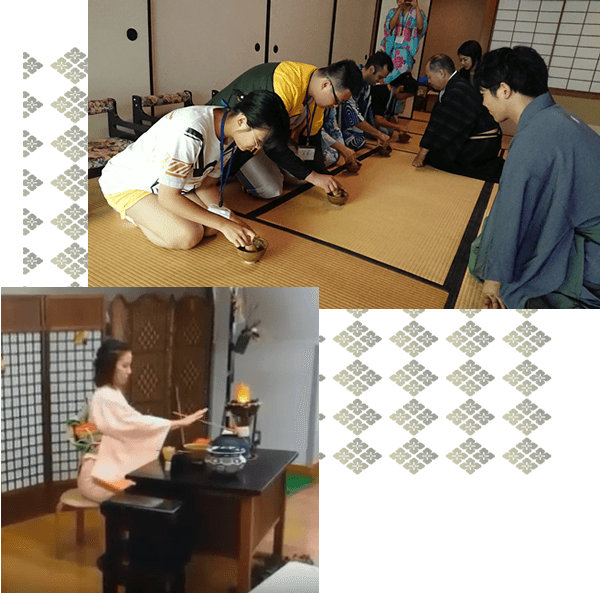
Flower Arrangement
Ikebana is the art of traditional Japanese flower arrangement originally related to religious ceremonies. Flowers were originally arranged where gods were welcomed or used as offerings at Buddhist altars.
When the tea ceremony became popular in the 16th century, flowers are arranged in tea ceremony rooms. There are now three major ikebana school Ikenobo, Ohara, and Sogetsu.
Moribana is upright style of Ikebana. This arrangement in the shape of three points of shin(center), soe(support), and hikae(overall balance),which indicate heaven(leader),earth(subordinate),and man(one to keep harmony in between)respectively. These three elements are called sansei (harmony between nature and man).
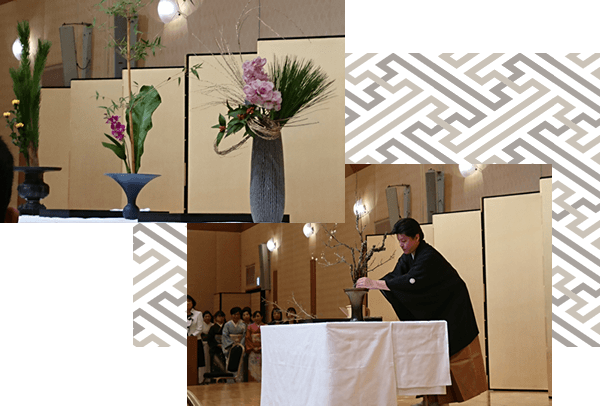
Japanese Ceramic (Fukuoka)
In the Japanese ceramic world, these is a category of tea ceremony pottery, which includes chawan (tea bawls), mizusashi (water containers), hanaire (vases), and kensui (rinsing-water bowls).
Tea ceremony pottery started to bloom during the Momoyama Period in Edo Age when Japanese warrior intently observed the traditions of Japanese tea ceremony.
In Fukuoka, we have three famous Japanese Ceramic wares named Takatori, Agano and Koisiwara.
Takatori ware developed by potters brought back from Korea during the Japanese invasions between 1592 and 1598. Takatori ware labored at the behest of the warlord Kuroda Nagamasa of the Kuroda clan (han).
Now Miraku Kamei XV and his son Mr. Hisaaki Kamei continue to produce the ceremony pottery "Takatoriyaki."
Koisiwara ware and Agano ware were produced in the eastern district of Fukuoka Prefecture. Mr. Zenzou Fukusima who produces Koisiwara wares became a living national treasure in 2017.
You can see many traditional Japanese wares.
Across Fukuoka 2F Gallery
1-1 Tenjin 1choume Chuou Ku Fukuoka City
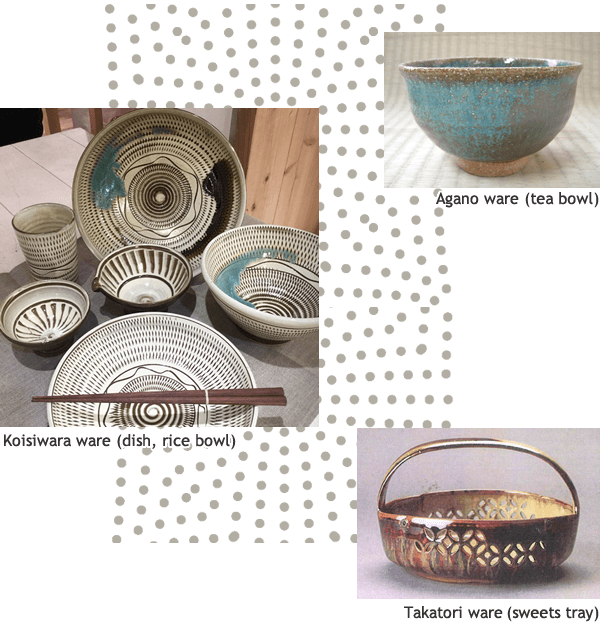
Chikuzen Biwa
The Biwa is a musical instrument that was played by blind priests.
The Biwa was improved in the middle of the Meiji period by Kyokuou Tachibana to create a new style of music.
This was the start of Chikuzen Biwa, culminating in a performace before the Emperor (Tennou), giving it a place in high culture.
In Fukuoka, Chikuzen Biwa is very popular with female artists, and the instruments were produced at the same level as Hakata dolls, a famous craft in the area during the Meiji period.
The most famous female chikuzen biwa performer is Kyokuen Nakamura belong to Chikuzen Biwa Asahi Kai. She was born in 1917 and was quite famous during the Shouwa period. She was a big star in Fukuoka. She continued to perform until the age of 95.(Now she is 101 years old) She has passed her skills to play along to many in this area, so Chikuzen Biwa is still used today.
Please watch videos of this cultural art linked on our Home Page.
